

A comet is a small body in the solar system that orbits the Sun and (at least occasionally) exhibits a coma (or atmosphere) and/or a tail — both primarily from the effects of solar radiation upon the comet's nucleus, which itself is a minor body composed of rock, dust, and ice. Comets' orbits are constantly changing: their origins are in the outer solar system, and they have a propensity to be highly affected (or perturbed) by relatively close approaches to the major planets. Some are moved into sun grazing orbits that destroy the comets when they near the Sun, while others are thrown out of the solar system forever.
A new comet may be discovered photographically using a wide-field telescope or visually with binoculars. However, even without access to optical equipment, it is still possible for the amateur astronomer to discover a sun grazing comet online.
Most comets are believed to originate in a cloud (the Oort cloud) at large distances from the Sun consisting of debris left over from the condensation of the solar nebula; the outer edges of such nebulae are cool enough that water exists in a solid (rather than gaseous) state. Asteroids originate via a different process, but very old comets which have lost all their volatile materials may come to resemble asteroids.
The word comet came to the English language through Latin cometes. From the Greek word komē, meaning "hair of the head," Aristotle first used the derivation komētēs to depict comets as "stars with hair." The astronomical symbol for comets accordingly consists of a disc with a tail of hair.
http://en.wikipedia.org/wiki/Comet
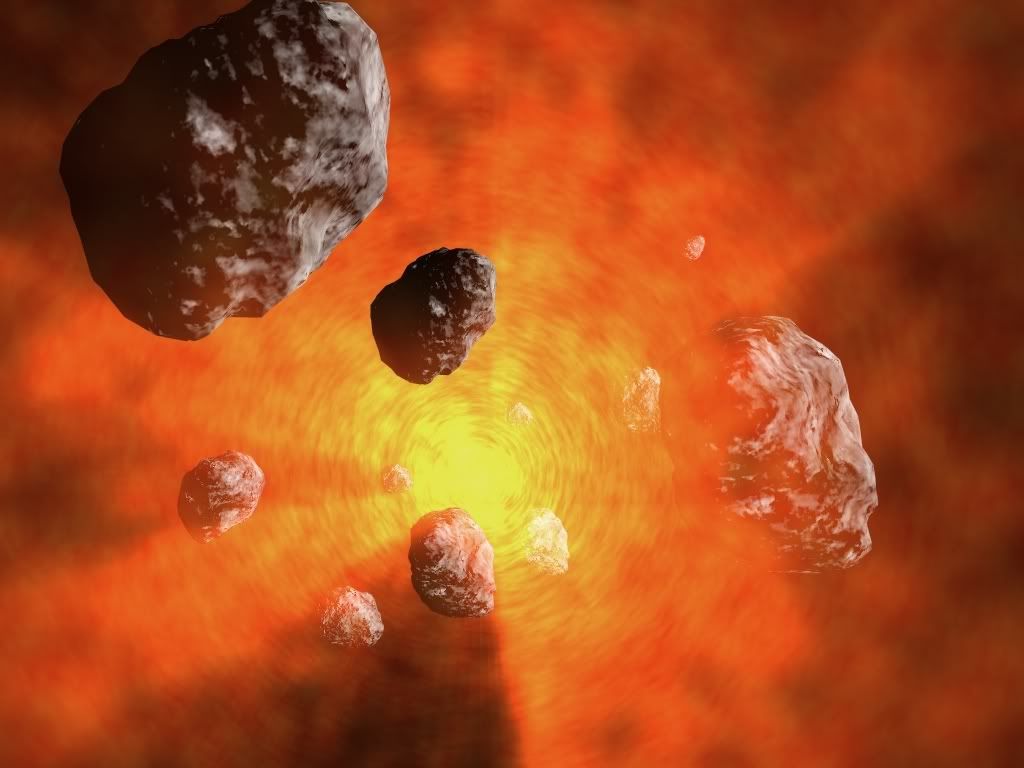
Asteroids, also called minor planets or planetoids, are a class of astronomical objects. The term asteroid is generally used to indicate a diverse group of small celestial bodies that drift in the solar system in orbit around the Sun. Asteroid (Greek for "star-like") is the word used most in the English literature for minor planets, which has been the term preferred by the International Astronomical Union; some other languages prefer planetoid (Greek: "planet-like"), because it more accurately describes what they are. In late August 2006, the IAU introduced the term "small solar system bodies" (SSSBs), which includes most objects thus far classified as minor planets, as well as comets. At the same time they introduced the term dwarf planet for the largest minor planets. This article deals specifically with the minor planets that orbit in the inner solar system (roughly up to the orbit of Jupiter). For other types of objects, such as comets, Trans-Neptunian objects, and centaurs, see Small solar system body.
The first asteroid to be discovered, Ceres, is the largest asteroid known to date and is now classified as a dwarf planet. All others are currently classified as small solar system bodies. The vast majority of asteroids are found within the main asteroid belt, with elliptical orbits between those of Mars and Jupiter. It is thought that these asteroids are remnants of the protoplanetary disc, and in this region the incorporation of protoplanetary remnants into the planets was prevented by large gravitational perturbations induced by Jupiter during the formative period of the solar system. Some asteroids have moons or are found in pairs known as binary systems.
http://en.wikipedia.org/wiki/Asteroid

A meteorite is a natural object originating in outer space that survives an impact with the Earth's surface without being destroyed. While in space it is called a meteoroid. When it enters the atmosphere, air resistance causes the body to heat up and emit light, thus forming a fireball, also known as a meteor or shooting star. The term bolide refers to either an extraterrestrial body that collides with the Earth, or to an exceptionally bright, fireball-like meteor regardless of whether it ultimately impacts the surface. The meteorite is the source of the light.
More generally, a meteorite on the surface of any celestial body is an object that has come from elsewhere in space. Meteorites have been found on the Moon[1][2] and Mars.
Meteorites that are recovered after being observed as they transited the atmosphere or impacted the Earth are called falls. All other meteorites are known as finds. As of mid-2006, there are approximately 1050 witnessed falls having specimens in the world's collections. In contrast, there are over 31,000 well-documented meteorite finds[4].
Meteorites are always named for the place where they were found,[5] usually a nearby town or geographic feature. In cases where many meteorites were found in one place, the name may be followed by a number or letter (e.g., Allan Hills 84001 or Dimmitt ).
Meteorites have traditionally been divided into three broad categories: stony meteorites are rocks, mainly composed of silicate minerals; iron meteorites are largely composed of metallic iron-nickel; and, stony-iron meteorites contain large amounts of both metallic and rocky material. Modern classification schemes divide meteorites into groups according to their structure, chemical and isotopic composition and mineralogy. See Meteorites classification.http://en.wikipedia.org/wiki/Meteorite
Meteorites and Impact
http://seds.lpl.arizona.edu/nineplanets/nineplanets/meteorites.html
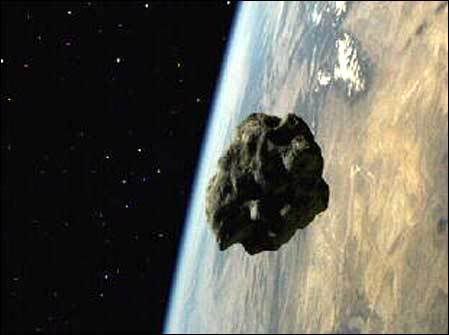
HOW TO IDENTIFY A METEORITE
http://epswww.unm.edu/iom/Howto.htm

Earth impact
http://www.unb.ca/passc/ImpactDatabase/
The Earth Impact Database comprises a list of confirmed impact structures from around the world.
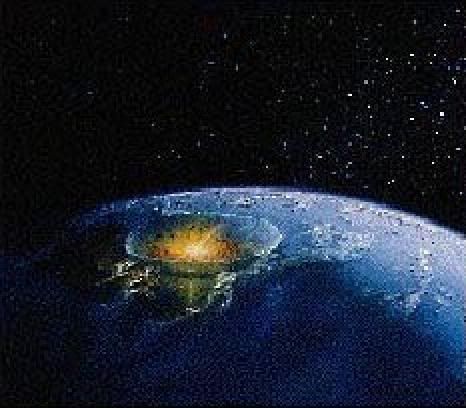
Asteroid Comet Impact Hazards
http://impact.arc.nasa.gov/
Asteroid Survival: How to Survive A Collision With An Asteroid
http://www.secretsofsurvival.com/survival/asteroid_survival.html
Astronomy Timeline
http://www.windows.ucar.edu/tour/link=/the_universe/uts/timeline.html
Timeline: Comet and asteroid impacts
http://space.newscientist.com/article/dn9974
4.5 billion years ago• A solar nebula condenses to form the planets, moons, asteroids and comets of our solar system. The planets' gravity propels comets outward to form the distant Oort cloud, and funnels most asteroids into a belt between Mars and Jupiter
3.8 billion years ago• The Late Heavy Bombardment: many massive impacts from debris left over after planet building, batter the Earth and Moon, and the inner planets, Mercury, Venus and Mars. The impacts are large enough to keep much of their surfaces molten
65 million years ago• An object – probably an asteroid about 10 kilometres across – crashes into what is now Mexico's Yucatan peninsula, forming a 300-km-wide crater called Chixculub. The resulting global hail of red-hot impact debris sets fires everywhere. The soot and dust of the impact and fires creates an "impact winter" lasting for many years, leading to the death of all dinosaurs and many other forms of life
50,000 years ago• A 50-metre-wide, nickel-iron meteorite slams into what is now Arizona, forming Meteor Crater – Earth's best-preserved large impact crater, 4 km across
613 BC• China's Annals record a great comet, now thought to have been the first known sighting of Halley's Comet and perhaps the earliest record of any comet
350 BC• Aristotle suggests that comets exist in the upper atmosphere, a view that held sway for nearly two millennia
312 AD• Roman Emperor Constantine claims to see a vision of a cross in the sky, causing his conversion to Christianity. Some think this was a comet, others that it was the flash of a meteorite impact
1066• A widely seen, spectacular appearance of Halley's comet, is recorded on the Bayeux Tapestry, which depicts the Norman conquest of England
1577• Tycho Brahe measures the position of a great comet and compares it with sightings from other places on Earth, proving it is at least four times further away than the Moon
1705• Edmond Halley makes the first prediction of the reappearance of a comet, proving that they orbit the Sun
1801• The first asteroid, Ceres is discovered, by Italian astronomer Giovanni Piazza
1908• An airburst over Tunguska, Siberia, flattens trees over hundreds of square miles, and the boom is heard thousands of miles away. It is later thought to be a comet that exploded high in the atmosphere. The blast released 500 kilotons of energy – the equivalent of a hydrogen bomb
1950• Fred Lawrence Whipple proposes the "dirty snowball" model of cometary nuclei, which still prevails
• Jan van Oort proposes that comets originate from a shell of billions of such objects thousands of times farther from the Sun than the Earth is. The region is now known as the Oort Cloud
1960• Geologist Eugene Shoemaker proves that Meteor Crater, Arizona really was produced by an impact. It was the first impact crater identified on Earth
1979• Luis Alvarez and colleagues publish the first paper linking the final dinosaur extinction to a massive asteroid impact
1980• The Spacewatch survey begins, at the University of Arizona, led by Tom Gehrels. This is the first systematic search for asteroids that might impact the Earth
1990• The Chixculub impact crater in Mexico, now buried deep below ground, is finally identified and tied to the impact that killed the dinosaurs
1992• US Congress-appointed panel proposes Spaceguard program to search for all near-Earth asteroids larger than 1 kilometre across within 10 years
1993• Comet Shoemaker-Levy 9 discovered. Resembling a string of pearls, it is the first known discovery of a comet shattered by a gravitational encounter with Jupiter. The dozens of pieces of the comet crash into Jupiter over a few hours in 1994
1995• The NEAT (Near-Earth Asteroid Tracking) project begins at an air-force tracking telescope in Hawaii. The rate of near-Earth asteroid (NEA) discovery increases more than tenfold
1996• The first discovery is made of an asteroid with an orbit computed to have a possibility of striking Earth
1999• The Torino Scale is published by astronomer Rick Binzel. It is an attempt to quell public fears about future near-Earth asteroid discoveries that have some small chance of striking Earth. It classifies all possible impacts on a scale with zero being no risk and 10 being virtually certain to cause global devastation.
2001• An asteroid is discovered that still has highest known possibility of impact. 1950 DA has 1-in-600 chance of striking Earth in 2880
2002• It is found that the Yarkovsky Effect can significantly alter asteroid orbits and therefore could be used to move one out of harm's way, just by spray-painting it white. The Yarkovsky Effect causes thrust, because of imbalances between solar energy reaching the object and heat being radiated out
2004• NASA's Stardust spacecraft flies by Comet Wild 2 on 2 January, gathering comet dust and taking close-up pictures
• The highest number yet on the Torino Scale (see above) is reported in December 2004 – it is 4. The asteroid is now called Apophis and improved orbital calculations have reduced the threat level 1
• NASA's Deep Impact spacecraft becomes first object deliberately sent into collision with a comet, called Tempel 1, on 4 July
• A method is proposed to move an asteroid from a collision course without touching it, using gravity alone
2005• The US Congress directs NASA to extend search for NEAs to all objects larger than 150-metres-wide, rather than those wider than 1 km
2006• NASA's Stardust spacecraft returns to Earth on 15 January, bearing samples of comet dust
2029• Apophis will make the closest approach to Earth ever predicted for a sizable asteroid on 13 April. It will come close enough to be visible to the naked eye and the Earth's gravity will change its orbit
2036• Apophis may impact Earth on 13 March – but only if it passes through a particular "keyhole" in 2029. The chances now stand at 1 in 6250
2082• Asteroid 2006 CS has a mere 1-in-77 million chance of striking Earth on 12 March – but it is 2.1 km across. An impact of that size could kill off most life on Earth. 2006 CS is by far the largest on the current list of objects with a small risk of impact
2102• Possible impact by 2004 VD17 on 2 May. This asteroid has only a 1-in-2777 chance of impact, but it is 580 m across and capable of continent-scale devastation
2880• Asteroid 1950DA has the greatest known probability of a major impact, on 16 March. The present odds are 1 in 600, and at about 1.1 km across, the asteroid is large enough to devastate most life on the planet
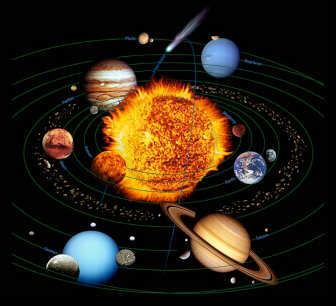
Esa, Nasa team up on key missions
http://news.bbc.co.uk/2/hi/science/nature/6767183.stm
The US and European space agencies are to co-operate on two missions considered vital for efforts to create a new understanding of the Universe.
Agency chiefs signed official agreements outlining the partnership in a ceremony at the Paris Air Show.
They will collaborate on the James Webb Space Telescope (JWST), due to launch in 2013, and the Lisa Pathfinder.
The James Webb observatory has been described as the successor to the Hubble Space Telescope.
US space agency (Nasa) administrator, Dr Michael Griffin, and European Space Agency (Esa) director-general, Jean-Jacques Dordain, signed the agreements on Monday at Esa's pavilion.
Dr Griffin said the agreement was "one more step along the path of international co-operation in space science and spaceflight of all kinds".
JWST will operate at visible and infrared wavelengths to shed a new light on the evolution of the Cosmos.
It should be able to see some of the farthest - and therefore the earliest - objects to form in the Universe.
See how the JWST will work
Light fantastic
JWST will operate at cryogenic temperatures so that it does not emit its own infrared radiation, swamping faint astronomical signals
Lisa Pathfinder is designed to try out the technologies required for the Laser Interferometer Space Antenna (Lisa) mission.
But developing the required technologies has tested the ingenuity of scientists and engineers to the limit, and some issues are still to be resolved.
Lisa itself is a joint Esa/Nasa mission and is intended to test a key prediction of Albert Einstein's Theory of General Relativity - that of gravitational waves.
Currently, our entire understanding of the Universe is based on observation of electromagnetic waves, such as visible light, infrared, radio and X-rays.
Einstein's thinking calls for the existence of "ripples" in space-time. These gravitational waves are expected to criss-cross the Universe at the speed of light; but their existence has yet to be observed directly.
By establishing the presence of these ripples, Lisa will open up a completely new field of astronomy.
Dr Griffin added: "Lisa is going to be a ground-breaking space mission when we finally accomplish it. There are things in astronomy and astrophysics that we cannot see with visible light, radiowaves or infrared.
"But we believe we can see them with gravitational waves. Lisa will detect those and allow us a new window into the Universe."
Modelling studies have suggested that Lisa should be capable of detecting remnant radiation from the Big Bang itself, enabling science to probe the first moments of creation and perhaps sort through some of its contradictory theories.
Sticky issues
The mission relies on technologies that have never been built before and cannot be properly verified on the ground. So Esa took the unusual step of pushing forward with a technology demonstration mission - Lisa Pathfinder - before attempting Lisa itself.
Lisa Pathfinder will place two test-masses in a nearly perfect gravitational free-fall, and controlling and measuring their motion with unprecedented precision.
This is achieved through inertial sensors, lasers, a drag-free control system and a remarkable micro-propulsion system.
Professor David Southwood, Esa's director of science told BBC News: "Lisa Pathfinder's been an enormous challenge, it turned out to be much harder than anyone expected. Nobody can deny that.
"We've been trying to do something different and we're still not fully out of the woods. For us, it's a grand goal. I would like to have done it for more like 200m euros; but we don't want to spoil the ship for a ha'pworth of tar.
"We want to get it right now. If anyone had any doubt whether the technology pathfinder was needed, the problems we've had on Lisa Pathfinder prove the case.
"It would have been a catastrophe to run into the problems we've had on the full mission. The taxi meter ticks more heavily when you're building a big mission."
Gravitational waves are thought to move in two different directions - so-called quadripolar motion - and Lisa will have to measure their movement in these two different directions at once. This was no easy task, said Professor Southwood.
UK prime
Professor Tim Sumner, a mission scientist from Imperial College London, UK, said the prospects of verifying one of the central predictions of general relativity "provides an enormously rich new discovery opportunity".
Lisa Pathfinder was originally slated for a 2008 launch, but is now expected to lift-off in 2010.
Esa's financial contribution to JWST amounts to roughly 400m euros, or 15% of the total $3.5bn budget. Esa has significant involvement on two of the telescope's four onboard instruments.
JWST will be launched aboard a European Arianespace rocket from Kourou in French Guiana.
The cost of Lisa Pathfinder is estimated at about 247m euros. Nasa will contribute systems to the spacecraft.
The industrial lead on Pathfinder was given to EADS Astrium in the UK. The mission is the first major Esa science project to be primed out of Britain since the Giotto comet chaser in the 1980s.
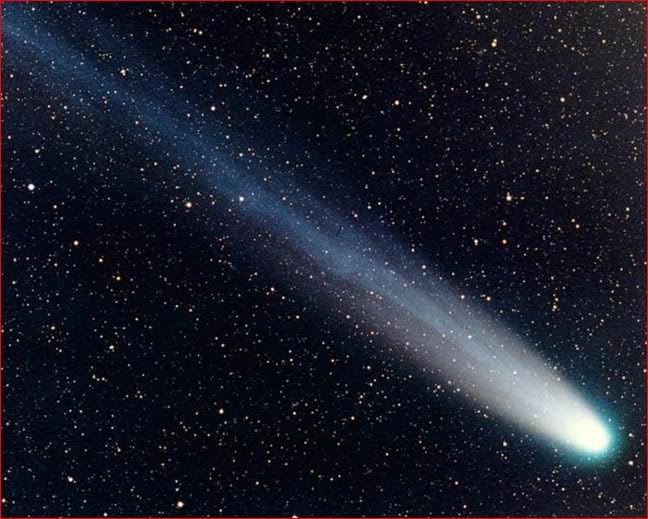
DID A COMET CAUSE FIRESTORM THAT DEVESTATED NORTH AMERICA 12,900 YEARS AGO?
http://www.andrewcollins.com/page/articles/Firestorm.htm
New evidence has emerged demonstrating that a massive firestorm from space devastated North America some 12,900 years ago, causing unimaginable firestorms, the return of the ice age and a 70 percent destruction of human population, all this according to new results gathered by a team of 25 researchers.
This incredible view of events centred around the end of the geological era known as the Pleistocene was presented last week to a stunned audience at the American Geophysical Union meeting in Acapulco, Mexico. It features also in the latest issue of NEW SCIENTIST magazine (194:2605, 26 May 2007, 8-9), from which this story is taken.
Scientists now believe that the cause of this continental sized cataclysm was a disintegrating comet, which fractured into tiny pieces as it entered the atmosphere from the north or northwest, causing massive explosions and fireballs.
A Continent on Fire
One of the three-main scientists speaking on behalf of the team, Jim Kennett, an oceanographer at the University of California, Santa Barbara, showed striking evidence from several sites of large scale wildfires that torched North America in the wake of the comet break-up. In his words" 'The whole continent was on fire.'
Evidence comes from a narrow 12,900 year old carbon-rich layer of sediment uncovered at no less than eight sites belonging to the Clovis horizon, as well as from several other sample sites of sediment in North America.
Extraterrestrial Debris
At many of the sites the scientific team have uncovered evidence of extraterrestrial debris, including what they refer to as nanodiamonds, tiny glass-like spherules which form rapidly when molten droplets cool rapidly in the air. They form usually during comet or asteroid impacts. Also discovered at the sites were rare helium-3 molecules, which are known to be more common in deep space than on Earth.
'You might find some other explanation for these individually,' said Richard Firestone, a nuclear analytical chemist working at Lawrence Berkeley National Laboratory in California, 'but taken together, it's pretty clear that there was an impact.'
He also believs that the obvious culprit is a comet, since the key sediment layers examined thus far have not produced characteristic evidence of high nickel and iridium content, found in connection with asteroid and meteorite impacts, such as that found in connection with the so-called KT Boundary Event suspected of wiping out the dinosaurs some 65 million years ago.
Obvious Skepticism
Naturally there is going to be wide scale objection to these staggering new theories, which have immense implications in other areas of science and literature, including the reality of Plato's account of the destruction of Atlantis, which might well preserve some semblance of the comet's impact on the Bahamas and Caribbean (see below). Many scientists, particularly those who believe that global cataclysms very rarely rock the world, are strictly against the team's theories.
'There is a tendency in this field to label any circular feature a crater,' says Michael Oskin of the University of North Carolina in Chapel Hill, who surely had in mind the famous Carolina Bays when he said these words. These are literally ten of thousands of elliptical craters, orientated northwest to southeast that cover large areas of not just the Carolinas but several states from New York down to Florida. Many are in swampland and filled with water, thus are taken simply to be wind-created lakes or ponds. Ever since their discovery in the 1930s, following the advent of aerial photography, there has been mounting speculation that the Carolina Bays, and other similar elliptical craters in the Yukon permafrost, are impact craters caused by either the aerial bombardment of meteorites, or the fragments of some more substantial object such a comet or asteroid, similar to that suspected of causing the Tunguska explosion in a remote forested region of Siberia in 1908.
It Came From the North
Since no large impact site has yet been found, Arizona-based geophysicist and team member Allen West, likewise offers the solution that the object was 'a low density object', i.e. a comet that fragmented into many pieces as it entered the atmosphere, causing a series of 'massive aerial explosions', each one similar to what happened in Tunguska back in 1908, which spread gradually southwards.
So far no epicentre for the proposed cataclysm has been determined, though the geologists are currently searching in the north of the North American continent, where some of the highest levels of extraterrestrial material have been found. This includes an archaeological site at Gainey in Michigan, which in 12,900 BP lay just beyond the southernmost reach of North American's primary ice sheet as it receded around the end of the last Ice Age.
A 400-kilometre long anomaly in the Hudson Bay is also being investigated as a possible rim of a giant impact crater. Yet if the comet did approach from the north or northwest, then it is likely that the largest and heaviest fragments reached further that suspected impact craters such as the Carolina Bays, meaning that marine geologists should be searching beyond their extent in the West Atlantic Basin (a subject also dealt with below).
Another possibility is that the main impact crater was created in the hundreds of metres thick ice sheet north of Michigan, which would have disintegrated, leaving relatively few traces, when finally the ice melted, bringing an end to the last Ice Age.
Younger Dryas
Another angle of this powerful discovery is that the 12,900 BP time-frame offered by the evidence of the overall cataclysm fits very well with the sudden re-advance of the ice sheet following some 2,000 years when it had been in withdrawal. This is known to geologists and climatologists as the Younger Dryas.
In the past, the Younger Dryas was put down to climate changes caused by melt waters from the ice sheets flowing into the Great Lakes, and then south through the Mississippi river into the Gulf of Mexico. This then allowed melt water to flow eastward into the Atlantic Ocean, helping to 'switch off' the ocean's saltwater-driven 'conveyor belt' current, bringing the entire Gulf Steam to a halt and triggering a mini ice age.
Now, however, there is growing speculation that the Younger Dryas might well have resulted from airborne debris caused by the impact and subsequent firestorms blocking out sunlight, as well as the release of melt water from the primary Ice Sheet that would indeed have flowed eastwards, opening up new drainage channels into the Atlantic Ocean.
'What we suggest is that the meltwater outflow from the proglacial lakes and from the temporarily melting ice sheet was the result of extraterrestrial impact,' Jim Kennett explains.
At the same time no less that 35 genera of the continent's species suddenly became extinct including camels, mastodons, ground sloths and horses, while the Clovis culture, which had flourished for at least a thousand years, diminished by an estimated 70 percent. Previously, the extinction of the Pleistocene animal species has been put down to either the Younger Dryas or over hunting on the part of the hunter-gathering Clovis culture.
However, from 12,900-year-old carbon-rich layers at Murray Springs, Arizona, as well as in sediment cores extracted from examples of the Carolina Bays, chemist Wendy Wolbach has detected 'significant quantities of soot', which is unquestionably a product of intense wildfires. Polycyclic aromatic hydrocarbons - another signature of wildfires, has also been detected at the team's sites by geologist Luanne Becker of the University of California, Santa Barbara.
The conclusion is obvious say the team. Huge wildfires swept across the North American continent following the impacts, destroying whole populations of animals and humans. 'I don't want to sound catastrophic here,' said Kennett, 'but this is wild stuff. There is significant evidence of massive biomass burning.'
Archaeologist Al Goodyear of the University of South Carolina, told the conference that there is 'indirect evidence of a human disaster in what is now the south-eastern US'. Distinctive style Clovis points suddenly disappear, only to be replaced around 12,700 BP by another style altogether known collectively as 'red points'. These then outnumber the Clovis point 4 to 1, which if an indication of the rapid depletion of the population, strongly suggesting that up to 70 percent of the Clovis population no longer existed.
As previously mentioned, it is going to be a hard struggle convincing cataclysm skeptics of this incredible new scenario at the end of the Pleistocene epoch. As Kennett jokes: 'You watch it, there will be blood on the streets.'
For further information, see the New Scientist online story 'Did a comet wipe out prehistoric Americans' found at environment.newscientist.com/article/ dn11909-did-a-comet-wipe-out-prehistoric-americans.html
THE NORTH AMERICAN COMET THEORY - THE GREATER IMPLICATIONS FOR PLATO'S STORY OF ATLANTIS
In the year 2000 my book GATEWAY TO ATLANTIS was published for the first time. It proposed that Plato's concept of Atlantis was based on stories reaching the Mediterranean in Plato's age of an immense cataclysm that rocked the Bahamas and Caribbean at the end of the Pleistocene epoch, causing fire to rain from the sky, unimaginable tsunamis and the drowning of low lying regions. Cuba was singled out as matching very well the description of Atlantis's central island, while the Bahamas was almost certainly the sunken lands where according to Plato no ocean going vessel could pass any more since it was now too shallow (which the Bahamas unquestionably is, following the rise of the oceans at the end of the last Ice Age).
The cataclysm I proposed that caused the destruction of Atlantis is identical to that being cited by the 25 strong scientific team at the American Geophysical Union last week. Using available evidence on the structure and dating of the Carolina Bays, a knowledge of the firestorms recorded in sentiments across the United States, as well as details of the flow of ice melt waters and the mass extinction of Pleistocene animals, I concluded that a comet had come out of the north-western skies and disintegrated into pieces, causing multiple aerial detonations across North America. This resulted in wide scale firestorms, massive explosions, tens of thousands of elliptical craters from the Yukon down to Florida, as well as the onset of the Younger Dryas, or mini ice age. This in turn led eventually to the end of the last Ice Age, with the drowning eventually of large areas of the Bahamas and Caribbean.
This much is now being proved correct, but if this is the case then scientists should also look at what I said happened as a result of this comet impact. German rocket scientist Otto Muck in his book THE SECRET OF ATLANTIS (1978, 1st UK edition) was the first to point out the existence of massive elliptical craters in the West Atlantic Basin, off the coast of Florida. He proposed that these were the result of an asteroid strike, which caused tremendous underwater earthquakes, ripping apart the tectonic plates that join to form the Great Atlantic Rift and pulling beneath the earth a whole continent that sat astride the ridge. This, of course, Muck concluded was the lost continent of Atlantis.
No evidence of this former island continent has ever come to light, even though the Mid Atlantic has been the chosen site of Atlantis ever since the theory was first proposed by granddaddy of Atlantology, Ignatius Donnelly back in 1882. Curiously, Donnelly was one of the first to take seriously the theory of a major cataclysm hitting the North American continent and causing mass devastation at the end of the Pleistocene epoch. It appeared in his book RAGNORAK: THE AGE OF FIRE AND GRAVEL (1883).
Using Muck's lead, I proposed in GATEWAY TO ATLANTIS that the apparent gigantic craters in the West Atlantic Basin were perhaps evidence of the largest parts of the aforementioned comet overshooting North America and crashing into the ocean. If so, then this would have produced massive underwater earthquakes and unimaginable tsunamis, which would have devastated the Bahamas and Caribbean to the south.
I found evidence also for the presence on the Caribbean islands prior to this time of Pleistocene animals such as the giant sloth, as well as the existence of species of snake on different islands that can only have thrived when the islands were linked together. In addition to this, myths and legends preserved by the former inhabitants of the Caribbean, as well as their descendents in South and Central America, spoke of a time when all the islands were joined. Then came a fire out of the sky, which was followed by massive flooding, which hit the islands twice. Afro-Caribbean islanders on Tobago even spoke of a time when the islands split after the 'old moon broke' and came crashing into the sea, presumably having learnt such stories from the indigenous peoples there beforehand.
All of the myths and legends, which derive from Bahamas in the north to the Lesser Antilles in the south, could be accounted for if it was shown that the larger fragments of the comet which had fragmented over North America at the end of the Pleistocene epoch ended up in the Western Atlantic Basin. If so, then there was every chance that almost all of the indigenous populations of the islands would have been wiped out, with only a few survivors left to tell the tale. Such stories were then retold across millennia, both in the islands and also by their descendents on the mainland, until finally they were conveyed to incoming Mediterranean traders either prior to or during the life of Plato, in the same way that similar stories were told to the first mariners to reach these same isles in the wake of Columbus.
These 'voyagers', the term used by Plato in his dialogue entitled the 'Timaeus', and later in the 'Critias', were most probably either Phoenicians out of Southern Spain or Carthaginians out of North Africa. The crews of these ocean-going vessels would also have had contact with Mediterranean ports such as those on Sicily, in Carthaginian hands during Plato's life. Having spent time there himself, he might easily have come across these rumours and stories of a once great island empire across the 'Atlantic Sea' devastated by earthquakes and floods, deciding to use them in his dialogues. One clue is the use of Semitic names in his Atlantis account, showing that his primary maritime sources came not from Egypt, as is always assumed due to the dialogues' use of Solon as the collector of these tales from the old priest of Sais, but from either Phoenician or Carthaginian sources, who spoke forms of the Semitic language.
Plato's suggestion that the cataclysm that devastated Atlantis either took place in 8500 BC (found in the 'Timaeus') or 9500 BC (found in the 'Critias'), is very close to the proposed dates for the end of the Pleistocene epoch. However, I suspect that these were the only real clues he got from Egypt, for they are very close to the time-frames given in temple chronologies for the age of the gods in ancient Egyptian tradition. Thus their connection with the destruction of Atlantis is merely a happy coincidence, although one that is now proving to be bizarrely accurate.
In my opinion, there is compelling evidence that Bahamas and Caribbean once supported a high culture with maritime capabilities prior to the cataclysm which devastated their island civilization. More and more examples of vast underwater features of human construction are coming to light off key Bahaman islands such as Bimini and Andros through the scientific work of Greg and Lora Little, and if it can be established that these predate what I call the Carolina Bays event, then this formed an important missing piece of the puzzle in our understanding of this cataclysm and its effects on the development of the Atlantic myth.
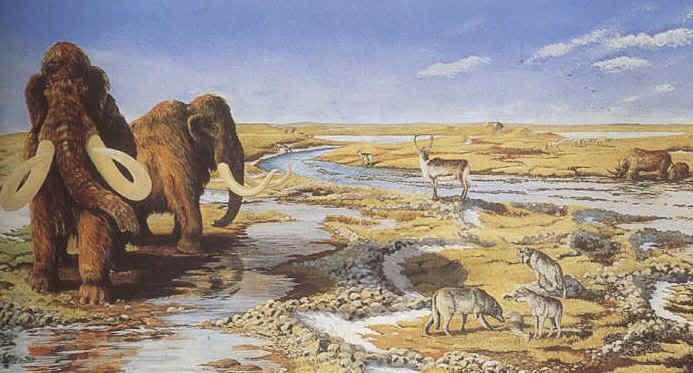
Comet pulling weight in mammoths’ demise
http://www.fortwayne.com/mld/journalgazette/living/17384785.htm
There are intriguing new clues in the mystery of how the woolly mammoth met its demise in North America more than 10,000 years ago.
For decades, scientists have debated whether the giant, elephant-like beasts were driven to extinction by the arrival of overzealous human hunters or by global warming at the end of the Pleistocene era, the last great Ice Age. Some say it was a combination of the two.
Recently, a group of more than two dozen scientists offered a new explanation. They have found signs that a comet – or multiple fragments of one – exploded over Canada about 12,900 years ago with the force equivalent to millions of nuclear weapons. That unleashed, they said, a tremendous shock wave that destroyed much of what was in its path and ignited wildfires across North America.
Another group, with the help of DNA evidence extracted from mammoth bones, teeth and ivory, has for the first time identified two distinct genetic groups among mammoths. They found that one group had died out by 40,000 years ago for unknown reasons, leaving the second to continue until the species went extinct.
The comet blast and firestorm could have dealt that death blow to the mammoth and more than 15 other species of large mammals, or mega fauna, including the mastodon, the saber-toothed cat, the American camel and the giant ground sloth, the other researchers said. They presented their findings last month at a meeting of the American Geophysical Union in Acapulco.
“The shock wave would have spread across the whole continent,” said Richard B. Firestone, a nuclear chemist at Lawrence Berkeley National Laboratory in California who helped do the research. “This event was large enough to directly kill most everything instantly. Those that survived would have found their food sources devastated, their water polluted, all kinds of things that would have made it difficult to go on much longer.”
In more than 20 locations from Arizona to Canada and California to the Carolinas, the scientists found glass-like carbon, microscopic diamonds, enriched iridium and other materials that they say are indicative of an extraterrestrial impact lying in a sediment layer corresponding to the time period.
Just above that layer they found charcoal soot, decayed plant life and other debris consistent with widespread burning.
Above that, the remarkable thing is what they did not find: further evidence of the mammoth and the other large animals.
“The mammoths come up to the line and not beyond it,” said James Kennett, a marine geologist and professor emeritus at the University of California at Santa Barbara. “At some sites, the black layer with impact material shrouds the bones.”
The comet theory is not wholly incompatible with earlier explanations for how the mammoth met its end. Researchers said it is possible that the Ice Age beasts, which stood about 9 feet tall and weighed three tons, struggled as the climate warmed, that increasingly skilled human hunters dramatically thinned their numbers, and that the exploding comet finished them off.
“Our theory is that if this event had not happened, that mammoths would still most likely – not certainly, but most likely – be wandering around North America now,” said Allen West, a retired geophysicist who is a leader of the research team.
The second group of researchers, in a study published recently in the journal Current Biology, analyzed DNA from 41 mammoths from Europe, Asia and North America. Radiocarbon dating found the oldest of the mammoths lived about 50,000 years ago, and the most recent specimens were from about 12,000 years ago.
Scientists found two distinct genetic groups among mammoths in northeast Siberia, indicating that the animals probably had existed in isolation during a warm phase thousands of years earlier and had come together when the glaciers – and their habitat – expanded again. Why one group died out they do not know, but the loss of genetic diversity theoretically leaves a species more vulnerable because the remaining population may be less able to adapt to changing conditions, the researchers said
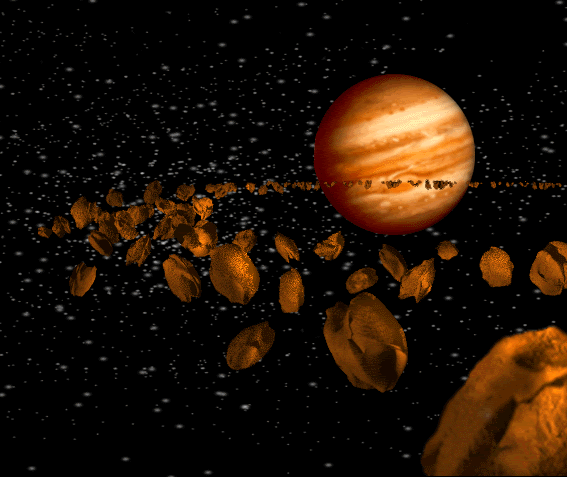
Dawn mission will explore two largest asteroids
http://www.wcfcourier.com/articles/2007/06/18/features/lifestyles/doc4676aa5ce65aa018449630.txt
If everything goes as planned, NASA will launch an incredibly interesting mission June 30. It is called the Dawn mission, and its goal is to visit and map out the two largest asteroids in the asteroid belt.
The first asteroid is Vesta. At 321 miles long, it is the second largest asteroid. The second asteroid is named Ceres. This asteroid is so big that it actually looks spherical like a planet, but at 600 miles in diameter it is much smaller than a normal planet. The most interesting thing about Ceres is its similarities to Earth. Scientists believe Ceres has an iron core and possibly lots of fresh water (in the form of ice) stored underneath the surface.
A Delta 2 rocket will take the Dawn spacecraft out of earth’s orbit. Then its ion engine will fire and send the spacecraft toward Mars. Dawn will slingshot past Mars in March 2009, arriving at Vesta in October 2011. In April 2012, the spacecraft will fire its ion drive again to leave Vesta and arrive at Ceres in February 2015, having traveled a total of 3 billion miles. The Dawn spacecraft will be the fastest ship NASA has ever built and also will be the first to orbit one body, then move to a second body and orbit it.
The goals of the mission are to map the two asteroids using an optical camera, then use two kinds of spectrometers to see what the asteroids are made of. The first spectrometer is like a super-specialized camera that helps scientists identify different minerals seen on the surface of the asteroid. The second spectrometer can detect hydrogen, carbon, oxygen and nitrogen, along with radioactive elements.
The data is sent via a 100-watt radio and a 5-foot diameter dish antenna to Earth, where gigantic dish antennas up to 200 feet in diameter pick up the faint signals so computers can decode them.
One of the things that NASA scientists hope to discover is why one asteroid looks like a lump while the other is a nice, spherical, planet-like object. Another goal is to understand exactly what elements make up these asteroids. The thought is asteroids can tell us what the earth might have looked like when it first formed, and with this information we can learn more about the origins of the earth, Venus and Mars. We may also learn a great deal about the beginnings of our solar system..
Asteroid belt
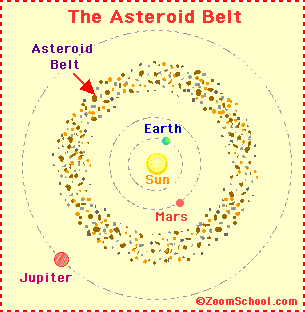
The asteroid belt is the region of the Solar System located roughly between the planets Mars and Jupiter where 98.5% of asteroid orbits can be found.[1] Asteroids, or minor planets, are small celestial bodies composed of rock and metal that orbit the Sun. This region is termed the main belt when contrasted with other concentrations of minor planets, since these may also be termed asteroid belts.
The asteroid belt formed from the primordial solar nebula as a group of planetesimals—the smaller precursors of the planets. However, the gravitational influence of Jupiter prevented these bodies from forming a planet, causing higher energy collisions between many of the planetismals and has since swept much of the resulting debris out of the region. Asteroid orbits continue to be perturbed whenever their period of revolution about the Sun forms an orbital resonance with Jupiter. At these orbital distances, a Kirkwood gap occurs as the asteroids are swept into different orbits.
The majority of the mass within the main belt is contained in the largest asteroids. The three largest asteroids in the main belt (individually named 4 Vesta, 2 Pallas and 10 Hygiea) have mean diameters of more than 400 km, while the main belt's only dwarf planet, Ceres, is about 950 km in diameter. Together these four objects make up about half of the mass in the belt. The remainder form a distribution of smaller bodies that range down to the size of a dust grain. The asteroid material is so-thinly distributed, however, that multiple unmanned spacecraft have traversed the belt without incident. Asteroids within the main belt are categorized by their coloration, and the majority form three primary classifications: carbonaceous, silicate and metallic. Collisions between asteroids can form an asteroid family, with members possessing similar orbital characteristics and coloration. These collisions also produce a fine dust that forms a major component of the zodiacal light.
http://en.wikipedia.org/wiki/Asteroid_belt
Japan's asteroid explorer begins voyage back to Earth
http://spaceflightnow.com/news/n0704/25hayabusa/
A small Japanese asteroid probe riddled by a streak of bad luck began its slow limp home Wednesday, but officials still face a myriad of challenges to bring the craft back in 2010.
Controllers sent commands for the Hayabusa probe to start one of its four ion engines Wednesday, officially beginning its three-year journey to Earth.
The milestone came after months of tests to determine whether the 900-pound spacecraft was healthy enough to attempt the voyage. Hayabusa is running on a damaged battery and just one of its four ion engines is currently deemed ready for long-term operations, according to the Japanese Aerospace Exploration Agency, or JAXA.
Hayabusa also lost two of its three fast-spinning reaction wheels responsible for attitude control. After the failures, the craft was forced to exhaust all of its chemical propellant reserves.
Engineers devised a new attitude control scheme using excess xenon fuel used by Hayabusa's electric propulsion system. Officials estimate Hayabusa's tanks still hold more than 66 pounds of xenon, while only about 44 pounds are needed for the Earth-bound leg of its mission.
JAXA officials remain cautious about the chances of Hayabusa successfully reaching Earth.
"This is not an optimistic operation, but a very tough operation," said Junichiro Kawaguchi, Hayabusa project manager, in a February interview. "The spacecraft is not in a very healthy state."
The probe is still located in the vicinity of asteroid Itokawa, a small potato-shaped space rock that was the subject of three months of scientific scrutiny by Hayabusa in 2005. Ground teams believe the spacecraft is currently about 50 million miles from Earth.
Hayabusa will have to complete two more orbits around the Sun before reaching Earth in June 2010, when it is expected to separate its return capsule for a parachuted landing in southern Australia.
The reentry vehicle was designed to house small chunks of Itokawa retrieved as Hayabusa swooped down to the surface of the asteroid. A small pellet was to fire into the asteroid to force dust and rocks into the sample chamber, but reviews of data streaming back from the spacecraft later caused engineers to question whether the system worked as planned.
Officials will likely not know for sure if the capsule contains any samples until it lands.
The start of the return trip was postponed by a year after a fuel leak in December 2005 threw Hayabusa off course and cut off communications with the probe for six weeks.
On Tuesday, JAXA released a heap of catalogued raw science data from Hayabusa's mission. The data included more than 1,600 optical images, about 135,000 pieces of spectral data in the near-infrared and X-ray bands, and 1.7 million data points from a laser rangefinder.
Scientists also assembled a three-dimensional shape video of Itokawa, which is believed to have been formed by the collection of several smaller bodies linked together by loose material and weak gravity.
Asteroid [BBC]
Asteroidal assassins
http://whyfiles.org/106asteroid/2.html
3.3 million years ago -- An impact in Argentina precedes numerous extinctions and a global cooling trend (more on this later).
50,000 years ago -- An iron meteorite a few dozen meters across gouges the 1.2 kilometer Barringer meteorite crater in Arizona.
1490 -- About 10,000 people die in the Chinese city of Chi1ing-yang when an asteroid breaks overhead.
1908 -- An asteroid estimated at 50 meters across explodes above Tunguska, Siberia, blowing down trees across 2,000 square kilometers and killing a thousand reindeer, but apparently no people. Because the stony object exploded in the atmosphere, there's no crater.
1937 -- Asteroid Hermes -- about a kilometer in diameter -- misses Earth by 600,000 miles. Hermes, although smaller than the 'roid that snuffed the dinosaurs, could have been a true "category killer," able to cause epic devastation and kill millions.
1950 -- Immanuel Velikovsky publishes "Worlds in Collision" (see bibliography), a pseudoscientific warning about impact hazards. In equal parts bogus and frightening, Velikovsky casts the entire field of impact studies into disrepute.
1980 -- Spacewatch program starts at the University of Arizona, intent on cataloging asteroids. The goal is to get a statistical picture of orbiting rocks anywhere in the solar system.
1980 -- Physicist Luis Alvarez and his team blames the dinosaur extinction on the environmental havoc of a collision. The resulting firestorm and a global soot and dust cloud, they argue, cooled the planet enough to make the dinos long for a package vacation in Cancun. Many scientists, including renowned comet hunters, smirk in their beer about this ridiculous notion, which only gains acceptance after a 180-kilometer wide crater is discovered north of the Yucatan.
1994 -- Comet Shoemaker-Levy 9 breaks apart, then smashes into Jupiter under the watchful eye of dozens of telescopes. The resulting zone of chaos is estimated to be as large as the Earth and lends urgency to the search for asteroids and comets. "Shoemaker-Levy was a turning point," says Benny Peiser, an anthropologist at Liverpool John Moore's University at the 2000 meeting of the American Association for the Advancement of Science in Washington, D.C. In the course of presenting results of the computer simulation on asteroid impacts, Peiser adds, "If it can happen in front of your nose -- practically in your backyard -- it can also happen on Earth."
1998 -- Astronomers announce that an asteroid may be on a collision course for Earth. The warning is quickly withdrawn after further observations.
1998 -- Peter Schultz, a professor of planetary geology at Brown University, associates greenish glass bodies found in Argentina with the extinction of 36 local animals (including one we'd love to see, a carnivorous, flightless bird). The glass contains iridium, the same chemical that helped prove the impact theory of dinosaur extinction. Still, correlation is not proof. "The climate change -- the sudden, dramatic cooling came immediately after the impact," Schultz says. "My gut says it's direct cause and effect, but we were careful to call this a coincidence."
2000 -- NASA's Near-Earth Asteroid Tracking System announces new data about large asteroids. "Until now, scientists thought the population of large, near-Earth asteroids was between 1,000 and 2,000, but we've downgraded that number significantly," said David Rabinowitz, now at Yale University. "We now believe there are between 500 and 1,000 near-Earth asteroids larger than one kilometer in diameter."
2000 -- Michael Paine, an Australian engineer, announces a new computer analysis of asteroid impacts indicating that asteroids may cause considerable chaos over a 100,000-year period. Most disturbing was a 5-kilometer asteroid, which exploded with a power of 23 million megatons, easily enough to wipe out the human population. Paine ignored this unsettling occurrence, since it was highly unlikely to occur in any given 100,000-year span. Still, he estimated the annual risk of a fatal asteroid impact at one in 90, and concluded that an average of 120,000 people died per event. A particular concern was tsunamis. When an asteroid hits the ocean, which covers about 70 percent of the planet, it can trigger a tsunami. According to the simulation, the average tsunami would kill 470,000 people.
Age of Dinosaurs Bracketed by Asteroid or Comet Impacts
http://astrobiology.arc.nasa.gov/news/expandnews.cfm?id=1391
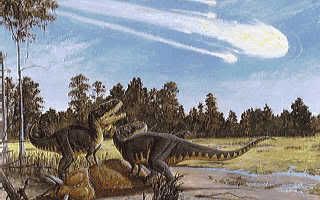
New research bolsters the theory that the age of dinosaurs not only ended with an asteroid or comet impact, but began with one as well.
During the Triassic period, early dinosaurs lived alongside and competed with other kinds of reptiles. But a mass extinction at the end of this period killed off many of the dinosaurs' rivals, freeing the dinosaurs to evolve quickly during the Jurassic period. Dinosaurs filled many of the ecological niches left vacant by other species, and dominated the food chain for 135 million years. Understanding the general principles that govern evolution is one of astrobiology's main goals.
Reseach led by Paul Olsen of the Columbia Earth Institute at Columbia University has found high levels of the element iridium in geological layers at the boundary of the Triassic and Jurassic periods, suggesting that an asteroid or comet struck Earth at that time.
The research team also noticed a dramatic increase in the number of fern spores in the soil at the Triassic-Jurassic boundary. The scientists believe that ferns repopulated the devastated environment early as part of a post-catastrophe ecosystem. Understanding how ecosystems react to environmental change is also a goal of astrobiology.
By examining geologic layers, the scientists discovered that the huge, meat-eating therapod dinosaurs sprang into being less than 30 thousand years after the extinction, a mere instant on the scale of evolution. Previous research by Peter Ward of the University of Washington revealed that the die-off at the end Triassic took place abruptly as well. The swiftness of the transformation seems to imply a sudden event, such as an asteroid or comet impact.
The research adds to the growing evidence that events originating in space exert tremendous influence on the course of evolution. Many scientists believe that an asteroid or comet impact wiped out the dinosaurs 65 million years ago , and led to the rise of the mammals.
Asteroid Caused Earth's Largest Mass Extinction
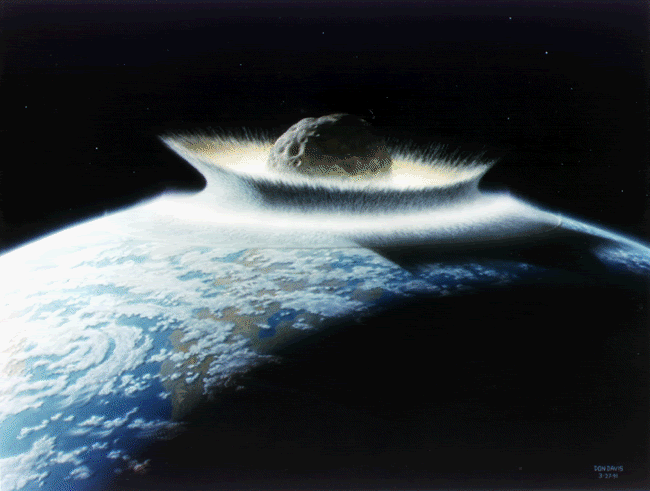
http://www.space.com/scienceastronomy/solarsystem/permian_impact_010829.html
Scientists working in southern China have added to previous research that supports the idea that an asteroid or comet smacked the Earth 251 million years ago, causing the planet's worst ever mass extinction.
Kunio Kaiho from Tohoku University and his colleagues found tell-tale elements in rocks from that geological time frame, the end of the Permian Period.
The cause of the extinction at the end of the Permian Period was much debated until recently. Researchers speculated that it might have been an asteroid or comet impact, like a later event that did in the dinosaurs. Or, they have ventured, it could have just been heavy volcanic activity or extreme climate change.
Then, earlier this year, a team led by a University of Washington researcher uncovered extraterrestrial gases trapped inside special molecules, known as Buckyballs, in ancient soil layers. Scientists say the evidence pointed to a colossal whack from a comet or asteroid roughly 3.7 to 7.5 miles (6 to 12 kilometers) wide -- about the same size as the one that ultimately destroyed most dinosaurs 186 million years later.
Now, Kaiho and his colleagues have found evidence of a planetary release of types of sulfur and strontium at the end of the Permian, along with a coincident concentration of mineral grains that appear to have been remelted due to an impact.
His team's discoveries at Meishan (Mei Mountain) suggest that an asteroid or a comet hit the ocean at the end of the Permian, triggered a rapid and massive release of sulfur from the mantle to the ocean-atmosphere system, swooped up a significant amount of oxygen, precipitated acid rain, and possibly set off large-scale volcanism.
"Understanding the cause of this event is important because it represents the largest mass extinction," Kaiho said, "and it led to the subsequent origination of recent biota on Earth."
The Five Worst Extinctions
Click here for a list of the five most lethal extinctions on our planet.
Kaiho discovered the significance of the site when he took samples from it in 1996 and again in 1998.
"We would like to clarify paleoenvironmental changes and causes of the end Permian mass extinction in different places and of the other mass extinctions which occurred during the past 500 million years: end Ordovician, Late Devonian, and end Triassic," he said.
The research was published in the September issue of Geology.
The extinction at the end of the Permian killed 95 percent of Earth's species, 53 percent of marine families and 70 percent of land species such as plants, insects and vertebrate animals. Because it was so effective at clearing out competition, this extinction is credited with paving the way for new lizards to walk the Earth -- lizards which evolved into dinosaurs.
Caribbean Frogs Spread After Meteor?
http://dsc.discovery.com/news/2007/06/11/islandfrogs_ani.html?category=animals&guid=20070611150030&dcitc=w19-502-ak-0000
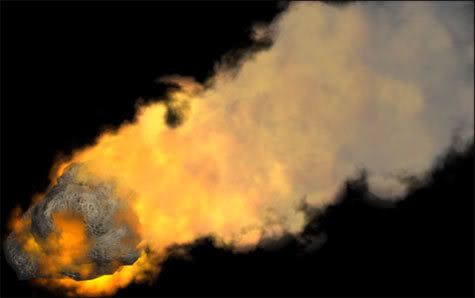

The same meteor impact that wreaked havoc with dinosaurs may have been the making of 162 species of Caribbean frogs, which descended from a single South American species, according to a new study.
All of the frogs are an odd sort — having no tadpole phase, instead hatching complete out of eggs. The 800 or so species of these Eleutherodactlus frogs — make up a fifth of all living frog species and compose the largest vertebrate genus.
In the world of biological classification, however, bigger is not necessarily better, explained Blair Hedges, a biologist at Pennsylvania State University.
The reason it's been the largest genus of vertebrates is because it's a taxonomic waste can," said Hedges. "These frogs don't give you a lot of characteristics to work with." In other words, many frog species fitting the same general description were dumped into the same genus — a level of classification just above species — simply for lack of better information.
Hedges and his coworkers have used genetic analysis to re-organize the waste can into a proper map of the Eleutherodactlus family tree.
Their study, which reveals a Caribbean branch to the family tree and supports the meteor impact connection, appears in the June 12 issue of the Proceedings of the National Academy of Sciences.
"Hedges and coworkers have tackled a vexing problem," said biologist David Wake of the University of California at Berkeley. What they found is that the very large number of frogs on Caribbean islands evolved there in the last 50 million years, after an initial invasion of a single species from South America.
This puts a new light on this radiation (of new species), and on the history of the Caribbean area," said Wake. It's also interesting, he said, that there were no later invasions of frogs from the mainland.
That could be because the ancestral Caribbean Eleutherodactlus frogs found the islands freshly wiped clean of predators by a mile-high, meteor-made tsunami.
"That may be why we're not finding old Caribbean groups," Hedges told Discovery News. The gigantic wave, triggered by the same meteor impact which created the Chicxulub crater off Mexico's Yucatan Peninsula, is believed to have scrubbed the Caribbean islands clean of life 65 million years ago, said Hedges.
The event created a unique opportunity for the first frogs arriving afterward.
That ancestral good luck of the Caribbean frogs is now apparently running out, said Hedges, in the face of a force almost powerful as a tsunami — deforestation.
"Ninety percent of their original habitat is gone. In some cases it's 100 percent in the lowland mahogany forests that are now furniture in Europe," he said.
In fact, just as biologists are beginning to understand how the Caribbean came to be, many of the species included in the study have already been driven to extinction.

Meteor Crater in Arizona
Meteor Crater
http://en.wikipedia.org/wiki/Meteor_Crater
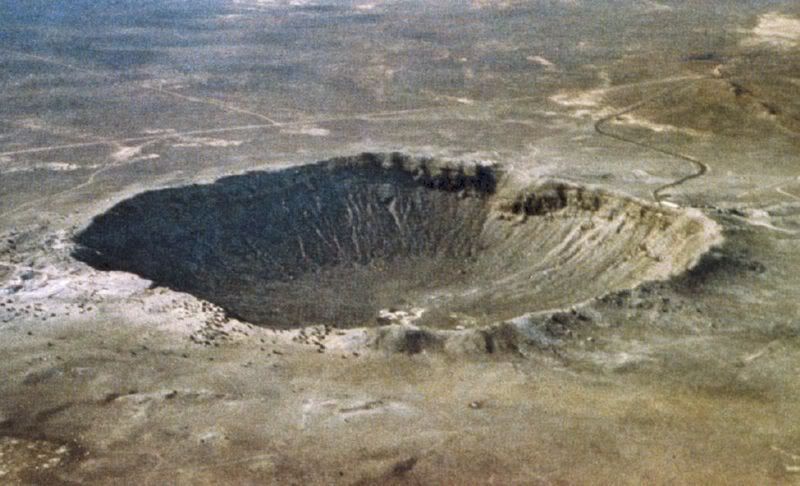
Asteroids and Secrecy: If End is Nigh, Do You Want to Know?
http://www.space.com/scienceastronomy/asteroid_secrecy_030224.html
Suppose a giant asteroid is heading toward Earth right now. Impact is certain. The consequences are expected to be globally devastating, with the human race among the casualties. The chances of doing anything about it are zero, the government decides.
Would you want to know?
Or would you prefer the Feds keep the information secret and spare you and your neighbors a bunch of pointless worrying?
In essence, the question concerns whether you'd prefer to die in ignorant bliss, or if you'd like some options. The alternatives might include dying in a panic, calmly making peace with your Maker, finally taking the kids to Disneyland or -- who knows? -- making a last-ditch effort to fight odds your elected leaders say are wholly against you.
For several reasons that will become apparent as you read on, the question is largely moot.
But that didn't stop it from coming up at a major science gathering earlier this month and generating a global round of conspiracy headlines. According to some articles, the U.S. Government has been advised to withhold information of a catastrophic impact, were one ever found to be imminent. The Times of London put this headline above its story: "Don't Tell Public of Doomsday Asteroid."
The media accounts centered around the words of one graduate student (the press variously and erroneously called him a scientist, a researcher and a government adviser). Geoffrey Sommer spoke as part of a seven-person panel Feb. 13 at an impact hazard symposium during a meeting of the prestigious American Association for the Advancement of Science (AAAS), held in Denver.
Controversial words
Here are the widely quoted words, from an AAAS press release, attributed to Sommer (much to his surprise, he said later):
"When a problem arises with high uncertainty, there is an opportunity to spin the problem to avoid global panic. If you can't do anything about a warning, then there is no point in issuing a warning at all. If an extinction-type impact is inevitable, then ignorance for the populace is bliss."
Those words were taken "severely out of context" and "inaccurately described my position," according to Sommer, who says he was not advocating a position but rather discussing choices involving information disclosure that policymakers would face. Yet the press release was sent out with, effectively, an AAAS stamp of approval, and for several days, all Sommer could do was watch as the comments generated ire among readers and some frustration on the part of scientists.
However misconstrued, the quote seemed to stem logically enough from a case study that was part of Sommer's doctoral dissertation at the RAND Graduate School, operated by the RAND Corporation (the media inaccurately placed him as an employee of the RAND Corporation working for the government). The dissertation's topic: Low-probability, high-consequence threats and how policymakers might evaluate them.
Whatever the circumstances, Sommer received some vitriolic responses to his words, which many saw as downright wrongheaded and arrogant at worst, pessimistic at best. Here are reactions from three separate people, based on e-mails supplied by Sommer himself:
"It's rather arrogant of you to presume that not a single human would survive after a large impact. Perhaps no one would. If people don't try, the odds are certainly worse."
"One doesn't have to be a RAND 'expert' to realize that the world would rather go down fighting, than to be lulled into a false sense of security."
"You are not God, Mr. Sommer I suppose if you were diagnosed with a rapidly progressing terminal illness, you would prefer to be told, 'All your tests came back OK, Mr. Sommer. There's nothing wrong with you at all.'"
The last note came from James Cass, who also told Sommer, "Your arrogance is pathetic." Upon reflection, Cass told SPACE.com: "I realize that some of my words were a bit acidic, but after I read Mr. Sommer's comments I was livid."
'Inconceivable'
Late last week, Sommer explained his true stance to SPACE.com. More on that shortly. First, the reaction of scientists -- most of whom were somewhat confused about what Sommer was actually trying to say -- shows how passionately they detest secrecy.
Across the board, experts in asteroid search efforts and death-by-space-rock risk assessment, collectively known as the Near Earth Object (NEO) community, contest whether secrecy could ever be warranted, let alone possible.
"It is inconceivable to me that anyone involved in NEO surveys and orbital predictions would want to keep the results a secret," David Morrison, who spoke at the same AAAS symposium, said in an e-mail interview. "It is also inconceivable that astronomers could keep such a secret even if they wanted to. A real impact prediction, even at low probability, would be known all over the world in a matter of hours."
That is true. In fact, dozens of amateur astronomers -- employed by no government or institution in their backyard endeavors -- help with the follow-up observations needed to pin down a newly discovered rock's actual trajectory. They work from data stored at two publicly available Web sites, one in the United States and one in Italy.
Journalists have frequently accessed these databases to fuel doomsday stories about asteroids that had long odds of ever coming in. In each case, the odds have dropped from highly improbable to zero in a matter of days or weeks.
The scare stories leave raw scars on the NEO community and its sense of credibility, perhaps making the researchers particularly sensitive to this latest round of doomsday headlines laced with suggestions of official cover-up.
Morrison, senior scientist with the NASA Astrobiology Institute at the Ames Research Center, called the whole affair a tempest in a teapot. He said there are no asteroids big enough to cause mass extinction currently in Earth-crossing orbits. Even a threatening comet, which by nature would start farther out in the solar system and might wander inward for the first time after centuries of deep space oblivion, would be spotted by amateur telescopes months before it hit, he said.
Real threat
Over time, orbits change, however. Asteroids that aren't threatening now might become so in a few centuries or millennia. All leading experts, Morrison included, agree that Earth will eventually get pummeled again by a 1-kilometer-wide (0.62-mile) object or bigger. Civilization might teeter. Odds are very slim, however, that it will happen in any given year or century.
It could come next year, or not for a million years.
(Scientists estimate there are 1,100 1-kilometer and larger NEOs; about 640 of them have been found. Hundreds of thousands of smaller objects roam the same region of space as Earth, so the impact odds for smaller, regionally destructive asteroids are greater in any given time frame. But the bulk of asteroid search funding and political discussion to date has focused on rocks above the 1-kilometer threshold.)
Sommer said that prior to his symposium talk, he had only two minutes to review the press release containing his comments, and it had already been distributed to reporters. At the meeting and in remarks since, he has worked to put it all into context.
"I don't advocate 'silence and secrecy' as absolutely as the AAAS press release indicated," Sommer wrote Feb. 15, two days after the symposium, in an electronic newsletter called CCNet, which monitors the science and politics of the NEO search and threat.
In the CCNet writings, however, Sommer did not appear to back down entirely from the idea that hiding information might be an option under certain circumstances in order to avoid social panic and the tremendous costs that might be associated with it (think looting, profiteering, and economic collapse, he says).
One point Sommer stressed is that the governments of this Earth need to get together and come up with a mitigation strategy -- what to do if an asteroid is found bearing down our pale blue dot.
Absent a plan to deflect or destroy an incoming asteroid, or to survive the hit, Sommer said policy makers might question the value of telling the public it is doomed.
CCNet is run by Benny Peiser, a social anthropologist who contemplates "neocatastrophism" in various forms. Peiser, of Liverpool John Moores University in England, responded: "Even with little time left for mitigation, many activities could be taken by the world community to attempt human survival of such a global disaster."
Peiser agrees with Morrison and others that in the case of a huge impacting object -- a planet destroyer -- there would be a lot of time to prepare and no possibility for secrecy. Sommer made it clear late last week that he agrees with these points, too.
Peiser also said science has not even reached a point where it can state with certainty whether an impact would doom humanity. Further, if a gargantuan incoming object is detected, it would be weeks, months or years before a firm determination was made that it was going to hit Earth, or not.
For the record
After the CCNet exchange, we asked Sommer to clarify his position.
"I absolutely do not advocate government keeping secret news of any impending disaster that would wipe out the world's population," Sommer said.
"I take no stand on what the policymakers should do," he said. "I most certainly never advocated that information be withheld from the public. In the purely hypothetical scenario at issue, my point is simply that policymakers should weigh the plusses and minuses of telling people they were about to die and that there was nothing that could be done to save them. It is a value judgment for the policymaker to make."
Sommer said the whole example is peripheral to his main point, which is that warning the public of an impending disaster "is a social function, not just a technical function, and that the costs of warning (including false positives) must be considered in the calculus of resource allocation and program design."
Meanwhile, researchers are concerned over how media coverage surrounding the affair might tarnish the public view of NEO science.
Clark Chapman, of the Southwest Research Institute and another of the symposium speakers, worries about the collective damage to scientific credibility from coverage of the Sommer controversy combined with hype surrounding previous asteroid scares. Chapman said individual flames of controversy tend to be small, but they get fanned "by those who prefer to see conflict rather than convergence and consensus."
Like other NEO researchers, Chapman is concerned that the public will come to distrust serious asteroid science and the need to search for, catalogue and understand space rocks, as well as to begin looking into mitigation strategies.
Importantly, as Sommer points out, there is no strategy, in the United States or elsewhere, for what to do in the face of a natural threat from space. And that, several other experts contend, is a legitimate concern.
At issue is how and whether to deflect or destroy an incoming rock, something no one knows how to do. Similarly important is the need to develop plans for moving coastal residents to higher ground. Because our planet is two-thirds water, any impact is likely to be an ocean splashdown, whose greatest immediate effect might be tsunami waves that could destroy coastal regions on two continents within hours.
The panic myth
At the heart of Sommer's case is how people would respond to the knowledge of looming cataclysm.
Lee Clarke, who advocates asteroid-mitigation planning, spoke at the AAAS asteroid symposium, too. The Rutgers University sociologist studies big-time catastrophes and the supposed public panic that comes with them. He says the whole concept that everyone freaks out is largely a myth.
"We have five decades of research on all kinds of disasters -- earthquakes, tornadoes, airplane crashes, etc. -- and people rarely lose control," Clarke said. "Policy-makers have yet to accept this. People are quite capable of following plans, even in the face of extreme calamities, but such plans must be there."
A scheme for survival would require good international communication and ought to be discussed in the United Nations, so that poorer countries are not left out of any world blueprint for notification and mobilization, Clarke said. "Earth's history is filled with unanticipated catastrophes and their disastrous consequences. With appropriate planning, the human toll could be lessened."
Clarke figures the worst thing governments could do is lose public trust by withholding information. But he points out that secrecy might appeal to some public officials.
"Keeping secret something potentially very dangerous is an idea that would resonate very well with the current administration in Washington," Clarke said. "It would probably resonate with most high-level decision makers."
In that light, "Geoffrey Sommer did the debate a great service by proposing a scenario that needs to be talked about," Clarke said, adding that the discussion was and should continue to be an intellectual one, regardless of whether scientists disagree on various points.
"The issue is big," Clarke said, "but the individuals are not."
CNN Report: Huge Asteroid coming our way....in 2029
Watch an asteroid
whiz by in 2029
Space rock’s close approach
should be visible to naked eye
http://www.msnbc.msn.com/id/6914766/
An asteroid expected to fly past Earth in 2029 will be visible to the naked eye, scientists projected Thursday.
It's a once-in-a-millennium event. And you may want to buy plane tickets now, as the flyby will be visible only from Europe, Africa and western Asia.
There has been no event like this in modern history. Some people have seen dramatic fireballs created by small space rocks blazing through Earth's atmosphere. And two house-sized asteroids have made closer passes. But they were not visible without telescopes.
The 2029 event will be the closest brush by a good-sized asteroid known to occur. The rock will pass Earth inside the orbits of some satellites. No other asteroid has ever been clearly visible to the unaided eye.
The asteroid is roughly estimated to be a little more than 1,000 feet (320 meters) wide.
It won't hit
The rock, catalogued as 2004 MN4, was discovered last June. It was seen again in December, and for a time scientists said it had the highest odds of hitting Earth ever given to a space rock. Subsequent observations refined the future path and eliminated those odds for the 2029 flyby. It won't hit the moon, either.
This week, NASA scientists used new observations from the Arecibo Observatory to further pin down the track of 2004 MN4.
On April 13, 2029, it will be about 22,600 miles (36,350 kilometers) from Earth's center. That is just below the altitude of geosynchronous satellites, which hover in fixed perches above the planet to communicate with and collect data on half the globe at all times.
Of the 10 known closest asteroid flybys, 2004 MN4 is by far the largest object, said Steve Chesley of NASA's Jet Propulsion Laboratory. Only two have come closer, and they were only tens of yards (meters) wide.
"All of the others in the top ten were discovered during the close approach, whereas for 2004 MN4 the close approach is predicted well in advance," Chesley said in a telephone interview.
Last fall, an even larger asteroid made a notable flyby. That rock, called Toutatis, is about 2.9 miles long and 1.5 miles wide (4.6 by 2.4 kilometers). Its closest approach, widely photographed, was about four times the distance to the moon. It was not visible to the naked eye.
What to expect
The asteroid 2004 MN4 is expected to shine like a fast-moving star at magnitude 3.3, Chesley said. That would be easily visible under dark skies without the help of binoculars or telescopes.
On this astronomers' magnitude scale, smaller numbers represent brighter objects. The brightest stars and planets have negative magnitudes. The dimmest stars visible under perfect sky conditions away from city lights are about magnitude 6.5. Urban residents may need to get out of town to see the rare event.
Chesley said the exact proximity of the object could cause its brightness to vary, but probably only by a few tenths of a magnitude.
Astronomers rule out asteroid risk in 2029
The asteroid will pass through the constellation of Cancer. Observers with clear skies in Europe, Africa and parts of Asia will be able to see a star-like point of light.
"Whether you could see it from the center of London is another matter," said Alan Harris of the Space Science Institute.
Harris notes that asteroid Vesta — 334 miles (538 kilometers) in diameter — periodically gets as bright as magnitude 5.3, which is visible to the naked eye under very dark sky conditions. "Curiously, Vesta attains this brightness at its opposition in July 2029, only a few months after the April 2029 apparition of MN4," Harris told Space.com.
With small telescopes and high-tech tracking software, the asteroid's shape could be evident.
"It will be potentially resolvable with small telescopes, but they'll have to be able to track pretty fast," Chesley said.
The rock will cover about 42 degrees of sky per hour, slower than a satellite but noticeably quick in the small field of view of a telescope.
Rare event
On average, one would expect a similarly close Earth approach by an asteroid of this size only every 1,300 years or so, Chesley and his colleagues have determined.
2004 MN4 circles the sun, but unlike most asteroids that reside in a belt between Mars and Jupiter, the 323-day orbit of 2004 MN4 lies mostly within the orbit of Earth.
The 2029 flyby will bend the rock's path and change the circumstances of later close passes to Earth. "However, our current risk analysis for 2004 MN4 indicates that no subsequent Earth encounters in the 21st century are of concern," according to a statement issued by Chesley and his JPL colleagues Paul Chodas, Jon Giorgini and Don Yeomans.
Additional observations in coming months and years could help eliminate the small chances of impacts in years after 2029.
Were an asteroid the size of 2004 MN4 to hit Earth, it would cause local devastation and regional damage. It would not be expected to cause any sort of global disruption, experts say.
Comet McNaught as seen in South Australia
Comet McNaught
CNN interview about a near hit by an asteroid
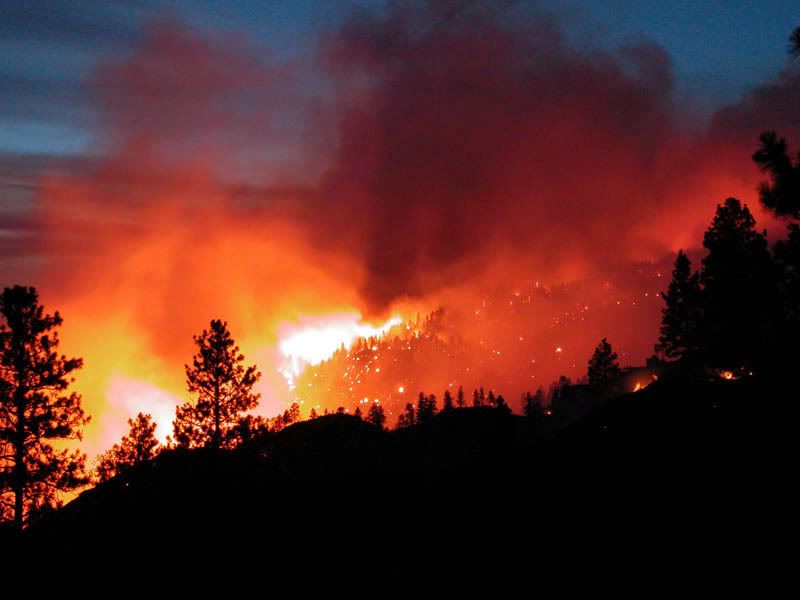

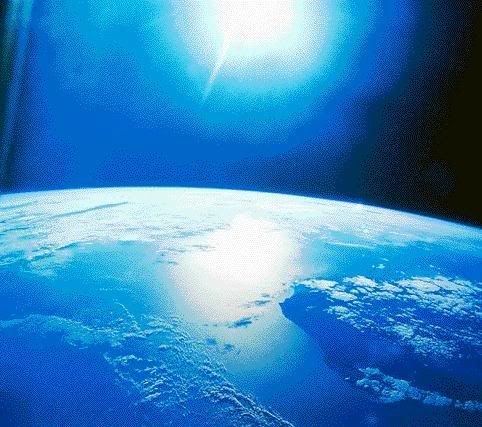












![Brotherhood" (2006) [TV-Series]](http://photos1.blogger.com/x/blogger2/1421/379621144723082/211/z/425926/gse_multipart33129.jpg)







No comments:
Post a Comment